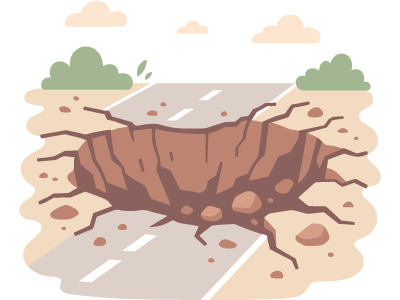Subsidence in St Albans: Do You Need a Surveyor?
The sudden appearance of the 20-metre wide by 10-metre deep sinkhole in St Albans delivered a clear picture of the devastation ground movement can cause to housing and infrastructure.
For prospective home buyers in high-risk areas of England and Wales, particularly those with clay soil or a history of historic mining, the priority must be thorough investigation. Subsidence can lead to multi-million-pound repair bills, and you cannot rely on assumptions.
The primary causes of ground movement in the UK
While the exact mechanics behind the St Albans sinkhole are debated (with historic brickmakers' clay pits often cited), the primary cause of subsidence across the South of England is the shrink-swell cycle of clay soil.
Clay soils absorb water in winter and swell up, but release it in dry summers and shrink, causing foundational movement. This situation is worsened by large trees drawing excessive moisture from the ground and by chalk layers or gypsum deposits beneath the surface.
Areas that have been mined over hundreds of years for various minerals pose a higher risk due to unstable ground voids that can suddenly collapse, leading to sinkholes or significant settlement.
In our recent survey, 16% of homeowners found defects; including 2% who were able to pull out of a bad purchase, 7% who were able to negotiate a better price, and sadly, 7% of homeowners who did not get a survey and discovered defects after the purchase.
12 of the 39 who remembered how much these defects cost to remedy spent over £5,000
Don't burn your money, book a survey.

Your best defence: RICS Home Survey
As a rule of thumb, if you find a crack in a property and you can fit the width of a 50p coin into it, it may indicate a serious problem with subsidence. However, this visual rule is no substitute for getting a professional RICS Home Survey.
It is always advisable to get a home buyer's survey whenever purchasing property because it places an expert, regulated by the Royal Institution of Chartered Surveyors (RICS), in your corner. They are trained to spot property defects and have years of experience detecting signs of potential ground movement.
Critically, your surveyor will not only know about the specific soil types prevalent in your area (like clay) but is also likely to have local knowledge of where previous subsidence problems have occurred. This combination of on-site inspection and local insight is invaluable.
The three actionable opinions on subsidence
Category 1 (No Problem) | The property shows no major signs of subsidence or ground movement. |
|---|---|
Category 2 (Negotiate/Investigate) | There are some suspicious signs. This may allow you to bargain with the vendor to share repair costs or immediately reduce the asking price. Further investigation may be recommended. |
Category 3 (Withdraw) | The property has serious, active subsidence. The likely expense and complexity of remedial action (underpinning) should make you consider withdrawing from the purchase. |
Should I buy a house with a history of subsidence?
You can, but proceed with extreme caution. You should only consider buying a property with historical subsidence if you have documentary evidence that the issue was formally fixed (e.g., underpinning) and certified by a structural engineer.
If the movement was only monitored but never fully remedied, the risk remains high. A RICS Home Survey is essential to verify the property's current stability before you exchange contracts.
The cost of fixing subsidence
If your RICS survey confirms a suspicion of serious or active subsidence, the remedial action required is typically underpinning.
This involves installing support beams or a second concrete layer to strengthen the property's weakened foundations and stabilise the ground underneath.
This specialist work must be carried out by a structural engineer and is extremely expensive. Underpinning can easily cost tens of thousands of pounds. You need a qualified, strong suspicion of subsidence from a RICS Surveyor before taking this expensive remedial action.
Survey vs Subsidence Report
As a buyer, you may also encounter a Subsidence Report. This is a standalone property search, often desk-based, that provides an overall risk assessment (ranging from 'Low' to 'Very High') of your property's vulnerability to ground movement, based on historical data and geological maps.
While the report is a useful first step, it is no substitute for getting a Home Survey. The report does not involve an on-site inspection.
Only a qualified and experienced RICS surveyor can physically inspect the property for visible symptoms, such as the '50p crack', and spot other crucial defects like damp, infestation, and rot.
Above all, you must ensure you secure adequate buildings insurance to cover potential losses in the event of a destructive event like a sinkhole or severe subsidence. Without it, you are literally risking your home and its full financial value.
Call or send us a message to request a callback or an email answering your queries about our surveys.
Our UK-based survey team can help you choose the right level of home survey for your property, at no extra charge.
There's no obligation to instruct. We'll make sure you understand your options and provide a free, fixed-fee quote for our best-value survey to meet your needs.
No robots, no call centres. Property challenges solved.
Andrew started his career in 2000 working within conveyancing solicitor firms and grew hands-on knowledge of a wide variety of conveyancing challenges and solutions. After helping in excess of 50,000 clients in his career, he uses all this experience within his article writing for SAM, mainstream media and his self published book How to Buy a House Without Killing Anyone.
Caragh is an excellent writer and copy editor of books, news articles and editorials. She has written extensively for SAM for a variety of conveyancing, survey, property law and mortgage-related articles.










